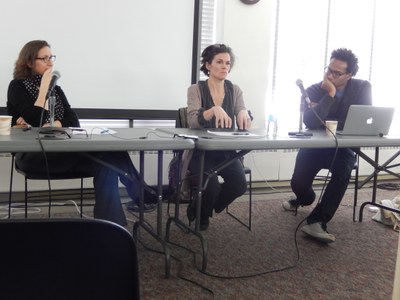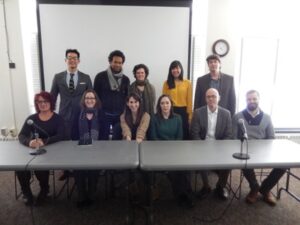Circuit, Current, Connection: Technology and its Literatures

Within the humanities, topics like data and networks are most often associated with contemporary fields such as new media. But the intellectual history of technology—as well as the social relations and cultural production that derive from it—is hardly a twenty-first century phenomenon and in fact has a deep tradition in American literature. On Friday, February 27th, the Center for American Literary Studies assembled six leading scholars to investigate the symbiotic relationship between technology, kinship, and literature traversing the nineteenth and twentieth centuries. By exploring radical shifts in media and mechanization over these two centuries, this graduate student-organized symposium aimed to redefine how such transformations have affected the way people related to each other and to the world.
The first panel, “Circuits: Kinship and America,” featured presentations that investigated the relations between print technologies and social relations in America. Nancy Bentley (University of Pennsylvania) probed the ways in which the Iroquois and white New Englanders “remade notions of kinship in relation to each other” via the technology of books; the “publication event,” she argued, helped constitute a modern, state-based society in opposition to an ancient, kin-based one. Scotti Parrish (University of Michigan) described how the “press of disaster” surrounding the Mississippi flood of 1927 helped to cultivate Richard Wright’s politics and aesthetics. The black newspapers of the time sought to expose the Jim Crow conditions of camps where blacks where often forced into rescue labor, and Parrish asserted that Wright thus forged his art as a disaster media critic. Ivy Wilson (Northwestern) discussed The Anglo-African—a daily newspaper and magazine—that formed new reading practices and communities among its black readers. While the daily newspaper was dedicated to urgent political matters (announcing the date and location of a rally, for example), the magazine fostered a new kind of temporality that tutored its readership to “mobilize the protocols of black bourgeois selfhood.”
The second panel, “Currents: America and the Body Electric” emphasized the connection between literary and technoscientific innovation. In his presentation, Maurice Lee (Boston University) located the widespread rise of quantitative thinking—such as statistics, demography, and meteorology—in nineteenth century pulp forms like adventure novels and saw it as a forerunner to today’s “information revolution.” He argued that such “enumerations that stirred the blood” were enchanting since new varieties of numerical excess could lead to new types of wonder. Dana Luciano (Georgetown) also touched on the concept of technological enchantment with her discussion of spirit photography. While modern audiences might smirk at the sepia-toned “ghosts” found in the portraits of William Mumler and his peers, Luciano argued that the camera was an information technology that advanced the spiritualist movement. Indeed, by capturing spiritual and erotic energy that was otherwise invisible, the camera became the primary “vehicle to document and advance queerness” in the nineteenth century. Moving into the twentieth century, Grant Wythoff (Columbia University) argued that the early formation of science fiction predates magazines like Amazing Stories and in fact could be sourced to electronic hobbyist newsletters. Ironically, mundane catalogs of radio parts and transistors eventually led to the imagining of fantastical mediating technologies and the futuristic worlds of modern speculative fiction.
Many of the talks presented various technologies as “events” that reshaped understandings of history and, thus, community. By offering what Bentley calls a “flash of new knowledge,” technology did not erase the past as much as offer radical new ways and structures of thinking. Across the presentations, the technological event also cohered with the affective experience of temporality, from the secular ecstasy of kinship to the public disgust of ecocatastrophe management. Another recurring theme was the recognition of technology as an instrument of truth. Whether in the form of The Anglo-African magazine or spirit photography, new technologies appeared to give society greater access to the unknown. In this respect, technology began to serve both a practical and an epistemological function in the nineteenth and twentieth centuries.
In exploring such timely topics, “Circuit, Current, Connection” helped to further two core goals of CALS: advancing the national research agenda of Americanist scholarship and cultivating the next generation of scholars. Led by its four graduate student organizers (Ting Chang, Juliette Hawkins, Derek Lee, and Erica Stevens), students played significant roles in establishing the symposium’s themes, selecting speakers, marketing the event, and running the panels. The symposium also allowed students to start building networks with some of the most exciting scholars in their fields. As this event amply demonstrated, CALS continues to create wonderful learning opportunities for Penn State students while also producing a forum for path-breaking scholarship in American literature.
 Grant Wythoff discusses the technological origins of science fiction.
Grant Wythoff discusses the technological origins of science fiction. Panel 1 fields questions from the audience during the Q&A session.
Panel 1 fields questions from the audience during the Q&A session. The symposium's organizers discuss overarching themes during the wrap-up session.Symposium organizers and panelists. Back Row: Derek Lee, Ivy Wilson, Scotti Parrish, Ting Chang, and Sean Goudie. Front Row: Dana Luciano, Nancy Bentley, Erica Stevens, Juliette Hawkins, Maurice Lee, and Grant Wythoff.***This news story was co-written by Derek Lee, Ting Chang, Juliette Hawkins, and Erica StevensFor more event photos, please visit the CALS photo album.
The symposium's organizers discuss overarching themes during the wrap-up session.Symposium organizers and panelists. Back Row: Derek Lee, Ivy Wilson, Scotti Parrish, Ting Chang, and Sean Goudie. Front Row: Dana Luciano, Nancy Bentley, Erica Stevens, Juliette Hawkins, Maurice Lee, and Grant Wythoff.***This news story was co-written by Derek Lee, Ting Chang, Juliette Hawkins, and Erica StevensFor more event photos, please visit the CALS photo album.

Within the humanities, topics like data and networks are most often associated with contemporary fields such as new media. But the intellectual history of technology—as well as the social relations and cultural production that derive from it—is hardly a twenty-first century phenomenon and in fact has a deep tradition in American literature. On Friday, February 27th, the Center for American Literary Studies assembled six leading scholars to investigate the symbiotic relationship between technology, kinship, and literature traversing the nineteenth and twentieth centuries. By exploring radical shifts in media and mechanization over these two centuries, this graduate student-organized symposium aimed to redefine how such transformations have affected the way people related to each other and to the world.
The first panel, “Circuits: Kinship and America,” featured presentations that investigated the relations between print technologies and social relations in America. Nancy Bentley (University of Pennsylvania) probed the ways in which the Iroquois and white New Englanders “remade notions of kinship in relation to each other” via the technology of books; the “publication event,” she argued, helped constitute a modern, state-based society in opposition to an ancient, kin-based one. Scotti Parrish (University of Michigan) described how the “press of disaster” surrounding the Mississippi flood of 1927 helped to cultivate Richard Wright’s politics and aesthetics. The black newspapers of the time sought to expose the Jim Crow conditions of camps where blacks where often forced into rescue labor, and Parrish asserted that Wright thus forged his art as a disaster media critic. Ivy Wilson (Northwestern) discussed The Anglo-African—a daily newspaper and magazine—that formed new reading practices and communities among its black readers. While the daily newspaper was dedicated to urgent political matters (announcing the date and location of a rally, for example), the magazine fostered a new kind of temporality that tutored its readership to “mobilize the protocols of black bourgeois selfhood.”
The second panel, “Currents: America and the Body Electric” emphasized the connection between literary and technoscientific innovation. In his presentation, Maurice Lee (Boston University) located the widespread rise of quantitative thinking—such as statistics, demography, and meteorology—in nineteenth century pulp forms like adventure novels and saw it as a forerunner to today’s “information revolution.” He argued that such “enumerations that stirred the blood” were enchanting since new varieties of numerical excess could lead to new types of wonder. Dana Luciano (Georgetown) also touched on the concept of technological enchantment with her discussion of spirit photography. While modern audiences might smirk at the sepia-toned “ghosts” found in the portraits of William Mumler and his peers, Luciano argued that the camera was an information technology that advanced the spiritualist movement. Indeed, by capturing spiritual and erotic energy that was otherwise invisible, the camera became the primary “vehicle to document and advance queerness” in the nineteenth century. Moving into the twentieth century, Grant Wythoff (Columbia University) argued that the early formation of science fiction predates magazines like Amazing Stories and in fact could be sourced to electronic hobbyist newsletters. Ironically, mundane catalogs of radio parts and transistors eventually led to the imagining of fantastical mediating technologies and the futuristic worlds of modern speculative fiction.
Many of the talks presented various technologies as “events” that reshaped understandings of history and, thus, community. By offering what Bentley calls a “flash of new knowledge,” technology did not erase the past as much as offer radical new ways and structures of thinking. Across the presentations, the technological event also cohered with the affective experience of temporality, from the secular ecstasy of kinship to the public disgust of ecocatastrophe management. Another recurring theme was the recognition of technology as an instrument of truth. Whether in the form of The Anglo-African magazine or spirit photography, new technologies appeared to give society greater access to the unknown. In this respect, technology began to serve both a practical and an epistemological function in the nineteenth and twentieth centuries.
In exploring such timely topics, “Circuit, Current, Connection” helped to further two core goals of CALS: advancing the national research agenda of Americanist scholarship and cultivating the next generation of scholars. Led by its four graduate student organizers (Ting Chang, Juliette Hawkins, Derek Lee, and Erica Stevens), students played significant roles in establishing the symposium’s themes, selecting speakers, marketing the event, and running the panels. The symposium also allowed students to start building networks with some of the most exciting scholars in their fields. As this event amply demonstrated, CALS continues to create wonderful learning opportunities for Penn State students while also producing a forum for path-breaking scholarship in American literature.
 Grant Wythoff discusses the technological origins of science fiction.
Grant Wythoff discusses the technological origins of science fiction. Panel 1 fields questions from the audience during the Q&A session.
Panel 1 fields questions from the audience during the Q&A session. The symposium's organizers discuss overarching themes during the wrap-up session.Symposium organizers and panelists. Back Row: Derek Lee, Ivy Wilson, Scotti Parrish, Ting Chang, and Sean Goudie. Front Row: Dana Luciano, Nancy Bentley, Erica Stevens, Juliette Hawkins, Maurice Lee, and Grant Wythoff.***This news story was co-written by Derek Lee, Ting Chang, Juliette Hawkins, and Erica StevensFor more event photos, please visit the CALS photo album.
The symposium's organizers discuss overarching themes during the wrap-up session.Symposium organizers and panelists. Back Row: Derek Lee, Ivy Wilson, Scotti Parrish, Ting Chang, and Sean Goudie. Front Row: Dana Luciano, Nancy Bentley, Erica Stevens, Juliette Hawkins, Maurice Lee, and Grant Wythoff.***This news story was co-written by Derek Lee, Ting Chang, Juliette Hawkins, and Erica StevensFor more event photos, please visit the CALS photo album.